NordBord Testing: New applications for training, monitoring and evaluation
Available in:
EN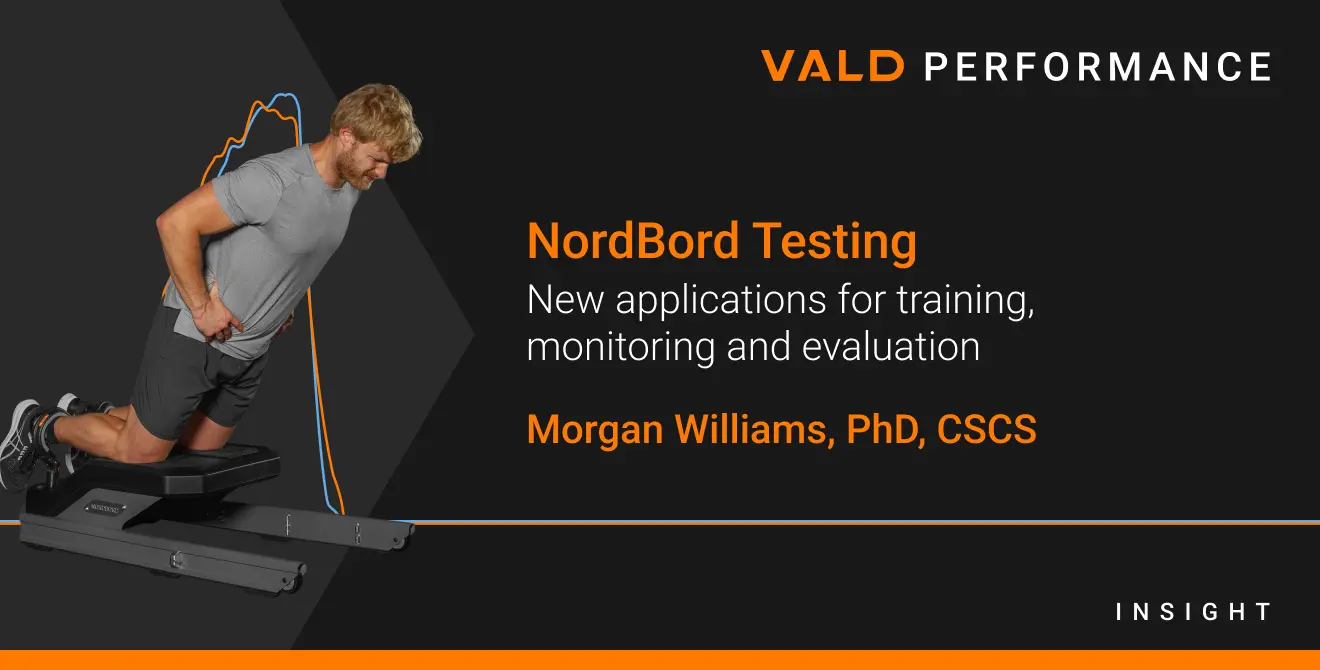
About the Author
Morgan Williams is a Data Scientist at VALD and Adjunct Associate Professor at Griffith University's School of Health Sciences and Social Work. As part of the VALD Data Science Team, Dr. Williams extracts new insights into VALD data and identifies how they can be used to enhance practice.
The NordBord is a widely used tool for hamstring testing, offering valuable insights into isometric (ISO-Prone test) and eccentric (Nordic test) strength. Comparing the peak forces obtained from ISO-Prone and Nordic tests provides practitioners with novel insights that can enhance training prescriptions, progress monitoring and injury risk assessment.
This blog outlines the new insights and how they can be used to enhance practice.
Three New Insights to Enhance Practice
Insight 1: Setting individualized target thresholds
An adequate eccentric training stimulus can now be identified when Nordic peak force is above the target threshold. ISO-Prone peak force can provide an individualized target threshold for Nordic training based on the properties of the muscle force-velocity curve and the differences between how force is produced during isometric and eccentric muscle actions.
Typically, when Nordic hamstring exercises are performed during training, the number of sets and reps are the focus and are recorded with little consideration for how the movement is executed.
Athletes and patients may complete training programs by performing the prescribed number of reps and sets of Nordics, but they might simply “drop” down without properly resisting the fall. This could mean the eccentric stimulus needed to promote the desired adaptations, such as improved muscle architecture and eccentric strength, is not achieved.
Using peak force from an ISO-Prone test as a target threshold can help determine if each Nordic rep has been completed adequately and avoid wasted time (Figure 1).
Using peak force from an ISO-Prone test as a target threshold can help determine if each Nordic rep has been completed adequately and avoid wasted time.
Insight 2: Determining when to add external load
The decision when to add external load to the Nordic hamstring exercise can now be supported using an objective measure. This objective measure can be determined by comparing Nordic to ISO-Prone test data. It represents the point when sufficient strength has been attained that bodyweight alone produces a peak force during a Nordic test that no longer exceeds ISO-Prone peak force (i.e., when the tests are equal).
The decision when to add external load to the Nordic hamstring exercise can now be…determined by comparing Nordic to ISO-Prone test data.
This objective measure assumes that, for a supramaximal eccentric training stimulus during the Nordic hamstring exercise, the force outputs must be greater than the maximal voluntary isometric force (i.e., ISO-Prone peak force). Nordics are a bodyweight exercise; they can, therefore, cause a ceiling effect for peak force.
In practice and research, the decision when to add an external load is often subjective, based on what the exercise “looks like” (i.e., the control displayed by the athlete or patient when lowering their body) or the ability to complete the full range for a given number of reps.
Instead, comparing peak forces from Nordic to ISO-Prone tests can add an objective approach to the decision-making process. Other considerations include the magnitude of the ISO-Prone, training background and the fitness status of the individual. Sample data from the VALD Data Lakehouse can be used to understand the relationship between the two NordBord tests and provide a guide for female or male athletes and patients (Figure 2).
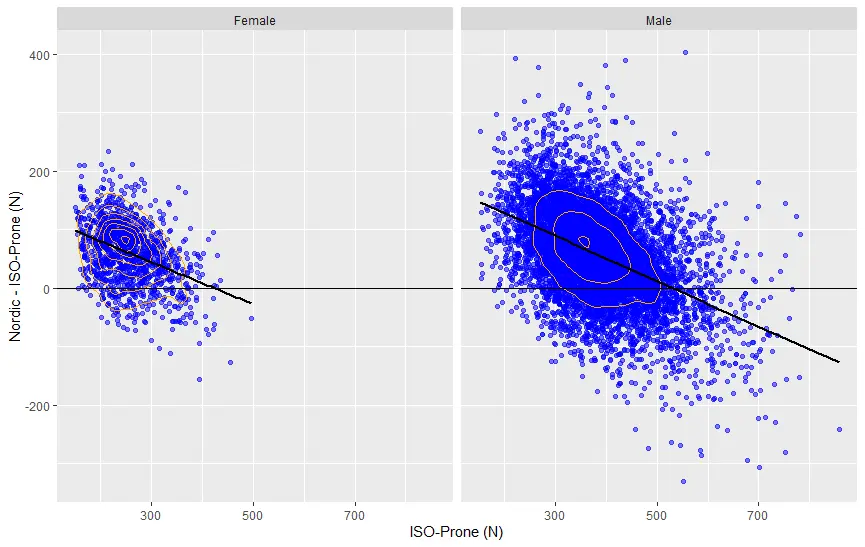
Insight 3: Identifying flags in test results
If peak force obtained from the ISO-Prone test exceeds the peak force from the Nordic test, it should raise a “flag” for further investigation.
If peak force obtained from the ISO-Prone test exceeds the peak force from the Nordic test, it should raise a “flag” for further investigation.
There are many reasons that this can happen, such as:
- the Nordic test was performed poorly,
- the Nordic test was too easy, requiring additional load or
- the athlete or patient has underpinning issues causing weakness that need attention (e.g., neural inhibition or delayed onset of muscle damage).
This could also indicate a potential injury risk, but regardless, it provides justification for further investigation.
Background
The NordBord is the established gold standard for eccentric hamstring testing in the field. Sensors connected to the hooks placed around the ankles provide the user with real-time feedback on every rep performed in the form of force output. The test protocols have been expanded from the original Nordic hamstring exercise to include:
The NordBord is not just for testing but is also an effective training tool providing real-time feedback. At present, the research surrounding Nordic training is focused on the number of reps and sets completed. However, we can now use the relationships between different tests to enhance exercise prescription, monitoring and feedback.
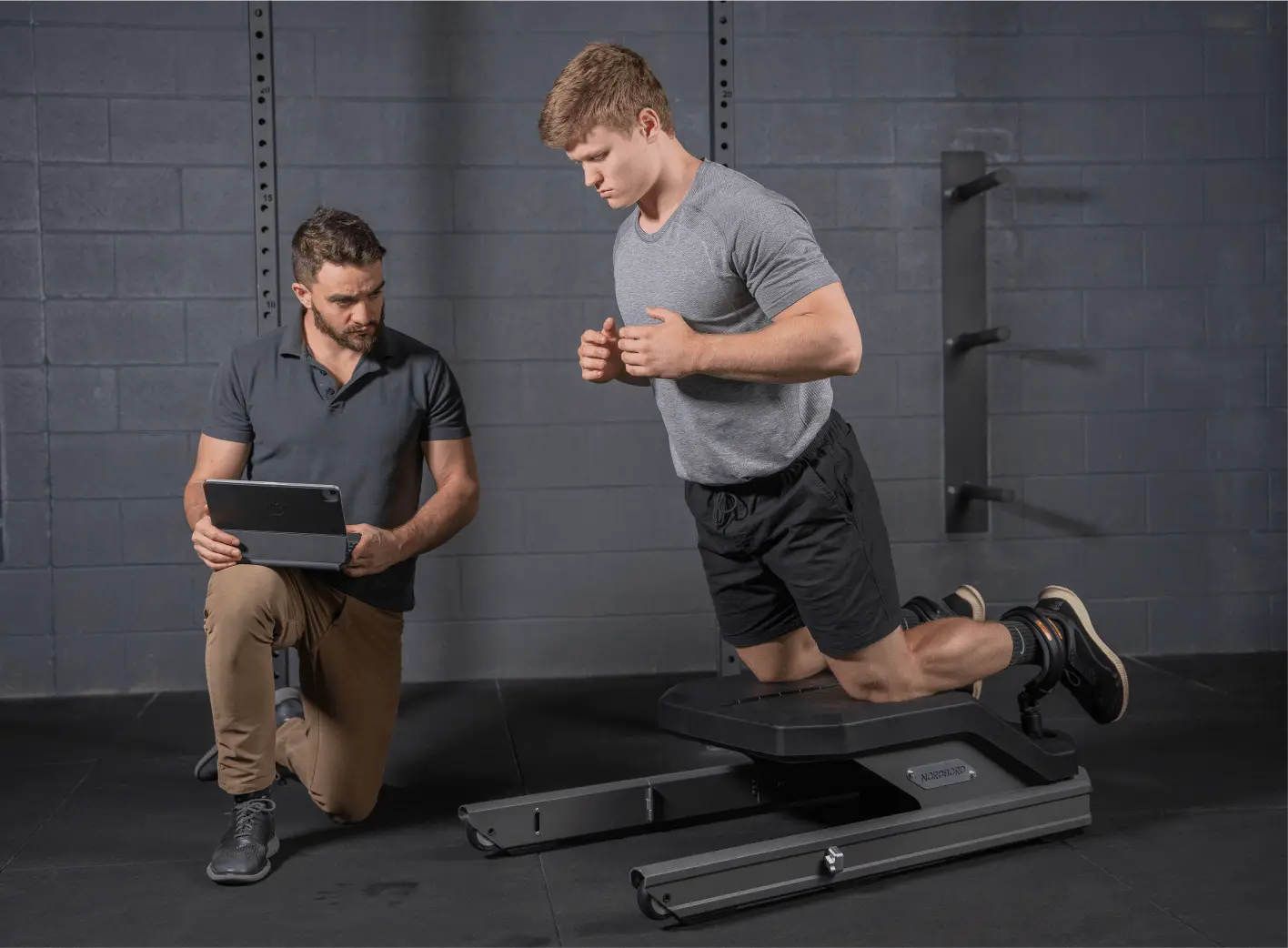
Nordic and ISO-Prone are the most used NordBord tests worldwide, accounting for millions of tests stored in the VALD Data Lakehouse.
Nordic and ISO-Prone are the most used NordBord tests worldwide, accounting for millions of tests stored in the VALD Data Lakehouse. These two tests have distinct differences according to the muscle actions tested:
- ISO-Prone tests involve a maximum voluntary contraction of the knee flexors performed isometrically, with the bodyweight supported and no movement.
- Nordic tests are performed kneeling on the NordBord and involve eccentric muscle actions of the knee flexors, where the knee slowly extends as the athlete or patient resists falling.
It is widely documented that eccentric muscle actions are stronger than isometric actions due to the way muscle fibers generate force. Figure 3 shows the muscle force-velocity curve, where eccentric muscle action is represented on the left. As the curve moves to the right, force output remains unaffected by velocity until isometric conditions (zero velocity) are reached. At this point, force output drops rapidly.
It is important to ensure high forces are produced when performing Nordic hamstring exercises, and this can be achieved by:
- continuing to resist without releasing tension before the full range of motion of the rep has been completed and
- ensuring the full range of motion is completed without pausing or stopping to prevent isometric conditions (i.e., lower force outputs at zero velocity).
If the Nordic test is performed correctly, it would be fair to expect ISO-Prone peak force to be less than Nordic peak force and an athlete or patient who is strong isometrically would also be strong under eccentric conditions (i.e., they are correlated).
If the Nordic [reps are] performed correctly, it would be fair to expect ISO-Prone peak force to be less than Nordic peak force and [someone] who is strong isometrically would also be strong under eccentric conditions…
Contrary to expectations, however, some ISO-Prone test results have been higher compared to Nordic peak force when testing elite athletes. Detecting these anomalies led to revisiting the research.
Timmins et al. (2016) found that only the eccentric force from the Nordic test differentiated between the group who remained uninjured and those who went on to sustain a hamstring injury that season (Table 1). Similar to our observations in the field with elite athletes, eccentric forces obtained from Nordic tests were lower than the isometric forces obtained from the ISO-Prone test.
Table 1: Preseason knee flexor strength data in elite soccer players
| Uninjured Group | Injured Group | Comparison Between Groups | ||||||
|---|---|---|---|---|---|---|---|---|
| Knee Flexor Strength | Two-Limb Average | Between-Limb Imbalance (%) | Uninjured Limb | Injured Limb | Between-Limb Imbalance (%) | Uninjured Group vs. Injured Limb | p Value | Effect Size (d) |
|
Eccentric Force (N) | 309.5 ± 73.4 | 10.1 ± 8.8 | 262.6 ± 63.2 | 260.6 ± 82.9 | 19.7 ± 32.4 | 48.9
(16.2 — 81.5) | 0.004 | 0.62 |
|
Isometric Force (N) | 373.7 ± 73.4 | 10.4 ± 7.6 | 365.2 ± 73.9 | 367.9 ± 72.7 | 12.1 ± 13.7 | 5.8
(-26.1 — 39.4) | 0.69 | 0.08 |
Adapted from Timmins et al. 1 (2016)
…only the eccentric force from the Nordic test differentiated between those who remained uninjured and those who sustained an injury… eccentric forces were lower than the isometric forces obtained from the ISO-Prone test.
Moreover, the difference between peak force from the Nordic and ISO-Prone tests was greater in the group who sustained a hamstring strain injury, with approximately a 107N difference in the injured group compared to a 64N difference in the uninjured group (two-limb average).
These unexpected cases, where peak forces from isometric tests are greater than eccentric tests, may provide useful insights about the execution of the Nordic hamstring exercise and flag areas for further investigation that are of great value to practitioners.
Insights from Comparing Eccentric and Isometric Strength
Using the NordBord, practitioners can gain meaningful insights by comparing eccentric and isometric hamstring strength tests to inform feedback, goal setting, training monitoring and injury risk.
To support this position, a sample dataset consisting of peak forces from Nordic and ISO-Prone tests was extracted from the VALD Data Lakehouse and analyzed. To be included in the dataset, an assessment had to include peak force from both a Nordic and ISO-Prone test collected on the same date. A total of 9,506 assessments were extracted, including 8,246 from males and 1,260 from females.
The descriptive statistics for age, body mass, Nordic peak force, ISO-Prone peak force and the Nordic - ISO-Prone difference are reported in Table 2 below. As expected, Nordic peak force (eccentric strength) was greater than ISO-Prone peak force (isometric strength) for both male (57N; 95% confidence interval = 56 to 59N; P < 0.0001) and female (60N; 95% confidence interval = 57 to 63N; P < 0.0001) groups.
Table 2: Descriptive statistics for the extracted dataset
| Female | Male | |||
|---|---|---|---|---|
| Quality | Mean | Standard Deviation | Mean | Standard Deviation |
|
Age (years) | 23.4 | ± 4.6 | 24.7 | ± 5.8 |
|
Body Mass (kg) | 65.9 | ± 8.6 | 80.6 | ± 10.7 |
|
Nordic (N) | 315 | ± 60 | 441 | ± 89 |
|
ISO-Prone (N) | 255 | ± 55 | 383 | ± 91 |
|
Nordic - ISO-Prone Difference (N) | 60 | ± 52 | 57 | ± 77 |
In addition, ISO-Prone and Nordic tests were positively correlated for both male (r = 0.63; P < 0.0001) and female (r = 0.59; P < 0.0001) groups (Figure 4).
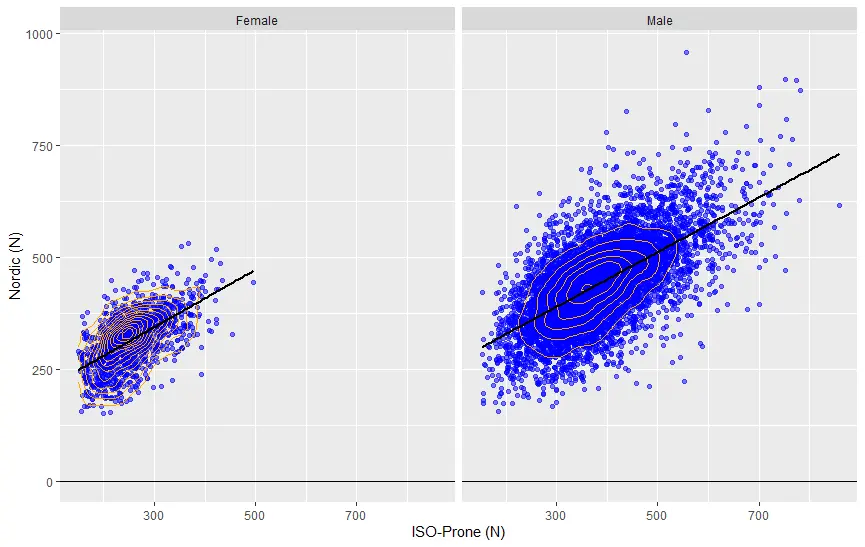
Exploring the Relationship Between Nordic and ISO-Prone Tests
ISO-Prone peak force may serve as the target threshold for eccentric training when performing the Nordic hamstring exercise on a NordBord. Based on the VALD Lakehouse dataset analysis, we can be confident in expecting that Nordic peak force will be greater than ISO-Prone peak force.
Furthermore, considering the characteristics of the muscle force-velocity curve and the differences in force production during eccentric and isometric muscle actions, the moment force output surpasses the ISO-Prone peak force target threshold during a Nordic hamstring exercise, it can be used to signify that an eccentric stimulus is occurring.
ISO-Prone peak force may serve as the target threshold for eccentric training using the Nordic hamstring exercise, measured on a NordBord.
To explore the suitability of the ISO-Prone peak force as a target threshold, the difference between Nordic and Iso-Prone peak forces was plotted against the ISO-Prone peak force for males (Figure 5) and females (Figure 6).
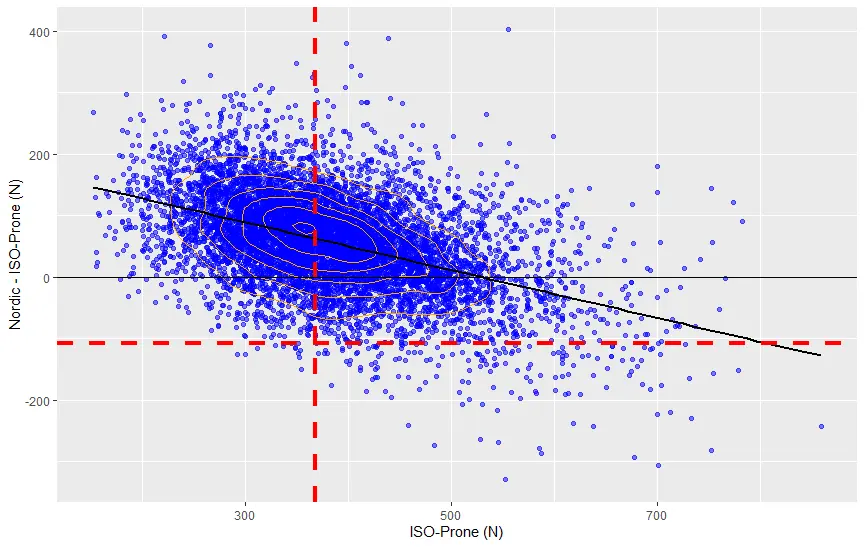
Figure 5: Shows the relationship between ISO-Prone peak force and the between-test differences (Nordic minus ISO-Prone) for males. The black line indicates the line of best fit. The red dashed lines indicate the mean data for the hamstring strain injured limb from Timmins et al.1 (2016).
In Figure 5, the scatter plot shows that – for most of the male sample – Nordic peak force is more than ISO-Prone peak force. However, the relationship is negative, and the difference between the two tests is reduced with higher ISO-Prone peak force.
From the VALD Lakehouse dataset analysis, when ISO-Prone peak force is approximately 530N, the between-test difference in peak forces has reduced so much that the line of best fit crosses zero difference (indicating that mean Nordic peak force equals the mean ISO-Prone peak force).
In these cases, when an athlete or patient reaches this level of strength, it would indicate an appropriate time to add an external load, since the Nordic hamstring exercise no longer provides a stimulus greater than what can be produced under isometric conditions.
Interestingly, when Timmins et al. (2016) data for the two NordBord tests (red dashed lines) is compared to the VALD Lakehouse dataset (Figure 5), the ISO-Prone peak force for the hamstring strain injured limb is within the normal range of the VALD Lakehouse dataset sample. However, Nordic peak force is well outside the normal range and considerably lower, suggesting a significant eccentric hamstring strength deficit.
For the uninjured limb and uninjured control group, the differences were smaller. However, eccentric strength remained lower on average than isometric strength and most likely reflected the lack of focus on Nordic hamstring exercise training at the time that the study was conducted. The use of ISO-Prone and Nordic peak force differences may offer a novel evaluation of training status and risk factors for hamstring strain injury, warranting future research.
The use of ISO-Prone and Nordic peak force differences may offer a novel evaluation of training status and risk factors for hamstring strain injury…
Figure 6 shows the ISO-Prone peak force by the between-test difference (Nordic minus ISO-Prone) relationship for females. The vertical black line indicates where the line of best fit crosses zero, suggesting that additional loading should be considered when the ISO-Prone peak force of approximately 420N is achieved.
This value is lower than that for the male sample and will depend on the athlete’s or patient's physical characteristics, which can be explored in a more complex model beyond the scope of this blog.
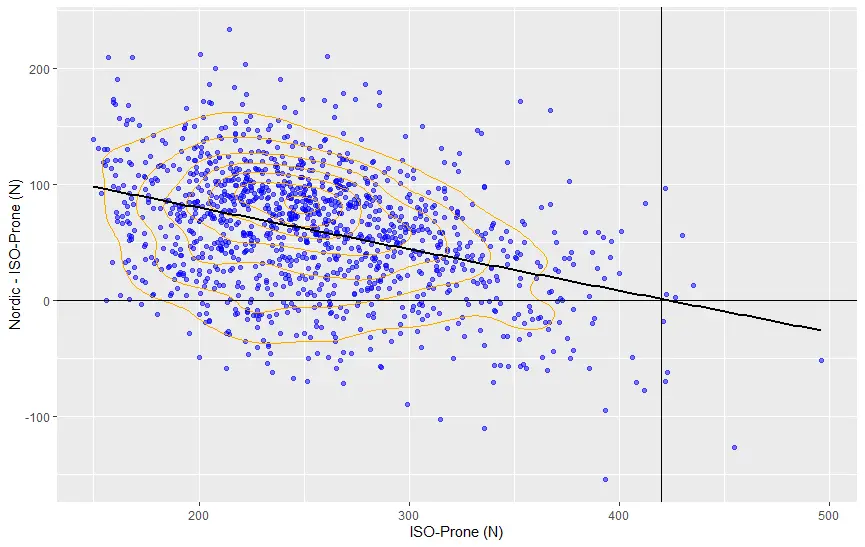
The negative relationship and crossing of zero differences between the two tests (for both females and males) suggests the ceiling effect (due to bodyweight) has been reached with the Nordic test. At this point, extra load may be required to provide sufficient stimulus for eccentric adaptations (note: this point is specific to the athlete or patient and would be impacted by body mass, age and sex).
The main takeaway here is that if the Nordic peak force is less than the ISO-Prone, there is now a sound justification to explore this further with the individual.
Practical Applications
Peak force measures from eccentric and isometric NordBord tests are correlated; use Nordic and ISO-Prone test associations to better understand your athlete or patient and improve training prescription, monitoring and decision-making processes. Incorporate the ISO-Prone test (if you do not already) as part of the warm-up before Nordic testing to minimize inconvenience.
Rather than generalizing from the literature, tailor your decision-making processes by comparing eccentric to isometric peak forces from NordBord tests. Make it specific to the athlete or patient and personalize the connections between testing and training.
Past research has identified weak eccentric forces produced during a Nordic as a risk factor for future hamstring strain injury, but the relationship between eccentric and isometric tests was not considered. Nordic tests should produce higher peak force compared to isometric tests performed on the NordBord. When they do not, it should be a flag to investigate further, as it may indicate:
- Poor eccentric strength (caused by neural inhibition, damage or prior injury) and potential risk of injury.
- Improper execution of the Nordic hamstring exercise or test.
- The ceiling effect (limited by bodyweight) has been reached and the addition of an external load (i.e., holding a weight) should be considered.
Nordic tests should produce higher peak force compared to isometric tests… When they do not, it may indicate poor eccentric strength, improper execution or the ceiling effect…
Enhance training feedback by using ISO-Prone peak force as a target threshold when performing Nordic hamstring exercises (Figure 1). Ensure your athlete or patient is getting the stimulus you have prescribed. Values above the threshold would suggest that the Nordic is being performed appropriately and that the stimulus is supramaximal (relative to isometric voluntary contraction).
When Nordic peak force is below the peak ISO-Prone force output, the attempt should not be counted as a rep. This tailored threshold may prevent reps from being counted in the absence of an adequate eccentric stimulus to drive the desired adaptations.
In the context of longitudinal monitoring, isometric and eccentric hamstring strength are modifiable factors and will fluctuate over time. A long-term decline in Nordic peak force while ISO-Prone peak forces remain stable may be a precursor to injury, indicating a flag to follow up with support staff.
In rehabilitating settings, ISO-Prone peak force can be the first target when introducing Nordic hamstring exercises into the program. In the future, VALD Lakehouse data can be used to model Nordic peak force from the ISO-Prone data, supporting opportunities for individualized training and monitoring strategies.
In Summary
This article, based on data extracted from the VALD Data Lakehouse, highlights how relationships between tests like Nordic and ISO-Prone can provide practitioners with valuable insights to enhance training, monitoring and injury prevention.
Exploring these outputs confirms that Nordic peak force should generally exceed ISO-Prone peak force. When this is not the case, understanding the underlying reasons will likely reveal critical insights that might otherwise be overlooked.
ISO-Prone peak force provides a practical threshold for guiding eccentric training and rehabilitation with the Nordic hamstring exercise. The relationship between these tests is a powerful tool for evaluating progress, refining training programs and assessing potential risks.
As practitioners, we must move beyond analyzing tests in isolation and focus on how their relationships can drive deeper, more impactful strategies.
If you are interested in integrating NordBord testing insights into your training and monitoring processes or want to explore how VALD’s human measurement technology can enhance your facility, get in touch.
References
Timmins, R. G., Bourne, M. N., Shield, A. J., Williams, M. D., Lorenzen, C., & Opar, D. A. (2016). Short biceps femoris fascicles and eccentric knee flexor weakness increase the risk of hamstring injury in elite football (soccer): a prospective cohort study. British Journal of Sports Medicine, 50(24):1524-1535. https://doi.org/10.1136/bjsports-2015-095362
